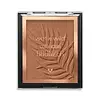What's inside
What's inside
 Key Ingredients
Key Ingredients

 Benefits
Benefits

 Concerns
Concerns

 Ingredients Side-by-side
Ingredients Side-by-side

Caprylic/Capric Triglyceride
MaskingSynthetic Fluorphlogopite
Boron Nitride
AbsorbentMicrocrystalline Cellulose
AbsorbentSilica
AbrasiveDimethicone
EmollientMagnesium Myristate
Dimethicone/Vinyl Dimethicone Crosspolymer
Skin ConditioningPhenoxyethanol
PreservativeLauroyl Lysine
Skin ConditioningCaprylyl Glycol
EmollientEthylhexylglycerin
Skin ConditioningHexylene Glycol
EmulsifyingTin Oxide
AbrasiveWater
Skin ConditioningO-Cymen-5-Ol
AntimicrobialTriethoxycaprylylsilane
Iron Oxides
CI 77492
Cosmetic ColorantCI 77499
Cosmetic ColorantMica
Cosmetic ColorantTitanium Dioxide
Cosmetic ColorantCaprylic/Capric Triglyceride, Synthetic Fluorphlogopite, Boron Nitride, Microcrystalline Cellulose, Silica, Dimethicone, Magnesium Myristate, Dimethicone/Vinyl Dimethicone Crosspolymer, Phenoxyethanol, Lauroyl Lysine, Caprylyl Glycol, Ethylhexylglycerin, Hexylene Glycol, Tin Oxide, Water, O-Cymen-5-Ol, Triethoxycaprylylsilane, Iron Oxides, CI 77492, CI 77499, Mica, Titanium Dioxide
Talc
AbrasiveMica
Cosmetic ColorantDimethicone
EmollientHdi/Trimethylol Hexyllactone Crosspolymer
Zinc Stearate
Cosmetic ColorantSilica
AbrasiveIsononyl Isononanoate
EmollientPentaerythrityl Tetraisostearate
EmollientCaprylyl Glycol
EmollientEthylhexylglycerin
Skin ConditioningCaprylic/Capric Triglyceride
MaskingCetearyl Ethylhexanoate
EmollientLaureth-23
CleansingNylon-12
Lauroyl Lysine
Skin ConditioningPhenoxyethanol
PreservativeLaureth-4
EmulsifyingSalicylic Acid
MaskingSodium Laureth Sulfate
CleansingVitis Vinifera Fruit Extract
Skin ConditioningTalc, Mica, Dimethicone, Hdi/Trimethylol Hexyllactone Crosspolymer, Zinc Stearate, Silica, Isononyl Isononanoate, Pentaerythrityl Tetraisostearate, Caprylyl Glycol, Ethylhexylglycerin, Caprylic/Capric Triglyceride, Cetearyl Ethylhexanoate, Laureth-23, Nylon-12, Lauroyl Lysine, Phenoxyethanol, Laureth-4, Salicylic Acid, Sodium Laureth Sulfate, Vitis Vinifera Fruit Extract
 Reviews
Reviews

Ingredients Explained
These ingredients are found in both products.
Ingredients higher up in an ingredient list are typically present in a larger amount.
This ingredient is an emollient, solvent, and texture enhancer. It is considered a skin-softener by helping the skin prevent moisture loss.
It helps thicken a product's formula and makes it easier to spread by dissolving clumping compounds.
Caprylic Triglyceride is made by combining glycerin with coconut oil, forming a clear liquid.
While there is an assumption Caprylic Triglyceride can clog pores due to it being derived from coconut oil, there is no research supporting this.
Learn more about Caprylic/Capric TriglycerideCaprylyl Glycol is a humectant and emollient, meaning it attracts and preserves moisture.
It is a common ingredient in many products, especially those designed to hydrate skin. The primary benefits are retaining moisture, skin softening, and promoting a healthy skin barrier.
Though Caprylyl Glycol is an alcohol derived from fatty acids, it is not the kind that can dry out skin.
This ingredient is also used as a preservative to extend the life of products. It has slight antimicrobial properties.
Learn more about Caprylyl GlycolDimethicone is a type of synthetic silicone created from natural materials such as quartz.
What it does:
Dimethicone comes in different viscosities:
Depending on the viscosity, dimethicone has different properties.
Ingredients lists don't always show which type is used, so we recommend reaching out to the brand if you have questions about the viscosity.
This ingredient is unlikely to cause irritation because it does not get absorbed into skin. However, people with silicone allergies should be careful about using this ingredient.
Note: Dimethicone may contribute to pilling. This is because it is not oil or water soluble, so pilling may occur when layered with products. When mixed with heavy oils in a formula, the outcome is also quite greasy.
Learn more about DimethiconeEthylhexylglycerin (we can't pronounce this either) is commonly used as a preservative and skin softener. It is derived from glyceryl.
You might see Ethylhexylglycerin often paired with other preservatives such as phenoxyethanol. Ethylhexylglycerin has been found to increase the effectiveness of these other preservatives.
This ingredient comes from a fatty acid (lauric acid) and amino acid (lysine). It is used to add a silky feel to cosmetics.
According to a manufacturer, its fatty acid base leaves a silky feeling on the skin. It also has emollient properties because of this. Emollients help soften skin by preventing water from evaporating.
Lauroyl lysine is barely soluble in water.
Learn more about Lauroyl LysineMica is a naturally occurring mineral used to add shimmer and color in cosmetics. It can also help improve the texture of a product or give it an opaque, white/silver color.
Serecite is the name for very fine but ragged grains of mica.
This ingredient is often coated with metal oxides like titanium dioxide. Trace amounts of heavy metals may be found in mica, but these metals are not harmful in our personal products.
Mica has been used since prehistoric times throughout the world. Ancient Egyptian, Indian, Greek, Roman, Aztec, and Chinese civilizations have used mica.
Learn more about MicaPhenoxyethanol is a preservative that has germicide, antimicrobial, and aromatic properties. Studies show that phenoxyethanol can prevent microbial growth. By itself, it has a scent that is similar to that of a rose.
It's often used in formulations along with Caprylyl Glycol to preserve the shelf life of products.
Silica, also known as silicon dioxide, is a naturally occurring mineral. It is used as a fine, spherical, and porous powder in cosmetics.
Though it has exfoliant properties, the function of silica varies depending on the product.
The unique structure of silica enhances the spreadability and adds smoothness, making it a great texture enhancer.
It is also used as an active carrier, emulsifier, and mattifier due to its ability to absorb excess oil.
In some products, tiny microneedles called spicules are made from silica or hydrolyzed sponge. When you rub them in, they lightly polish away dead skin layers and enhance the penetration of active ingredients.
Learn more about Silica